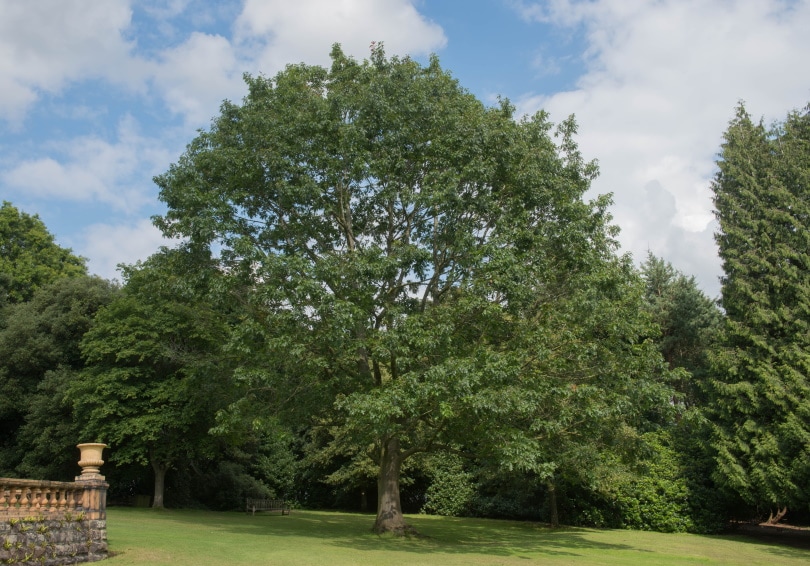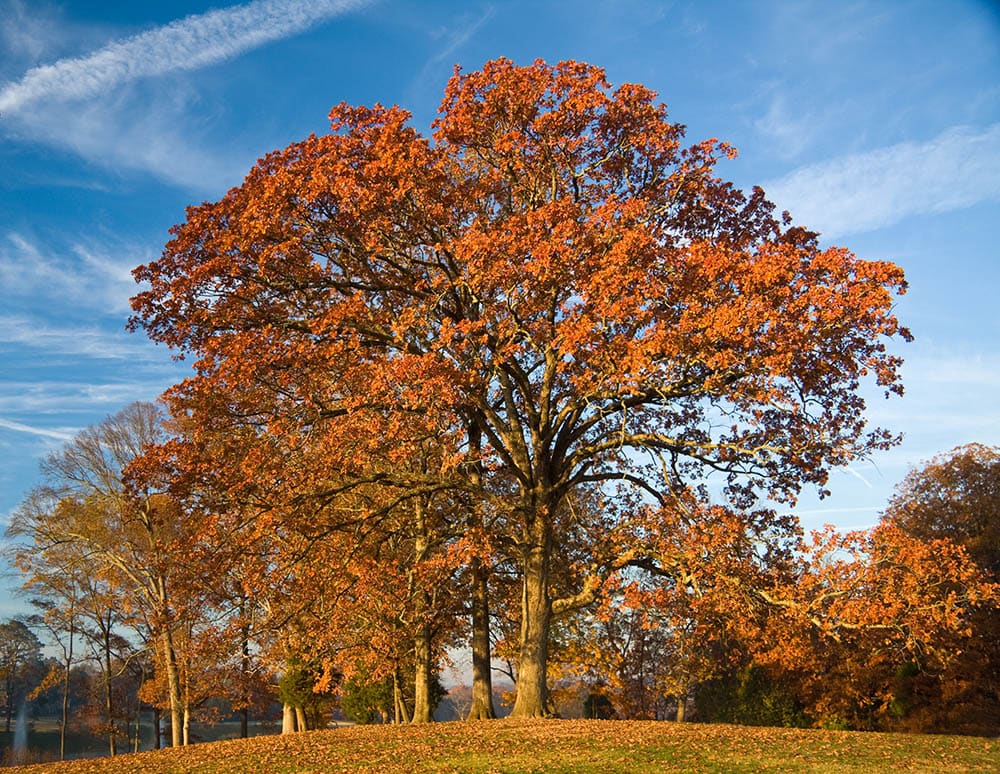10 Different Types of Deciduous Trees (With Pictures)
-

- Last updated:

Deciduous trees are among the most ubiquitous trees globally. They even grow in commercial areas, parks, and backyards. The trees have unique characteristics that make them a favorite of many homeowners. Among the unique characteristics is the shedding of their leaves during certain times of the year.
Several deciduous trees have adapted to a wide range of climates and conditions. They change their appearance during specific times of the year in preparation for winter hibernation. Here are some of the most popular types of deciduous trees.
 The 10 Different Types of Deciduous Trees
The 10 Different Types of Deciduous Trees
1. Maple (Acer)

| Average Tree Height: | 10 to 45 meters |
| Average Diameter: | 10 to 17 inches |
| Where Found: | Asia, Northern Africa, North America, and Europe |
Maple trees are native to the Northern Hemisphere. There are over 125 species, and most of them are native to Asia. The maple tree is known for its green, yellow, and orange foliage. Some species have red leaves. But once the fall arrives, the leaves turn bright orange and yellow before falling off the tree.
These small-to-medium-sized trees have a rounded growth habit. They do well when planted in moist soil. Besides its decorative purposes, the maple tree is also used for making maple syrup and maple sugar. They are also used as shade trees and street trees because their branches grow horizontally and not vertically.
Sugar maple is one of the most popular kinds of maple. It’s because they produce a high volume of sap. Other examples of maple trees include red, silver, and bigleaf maples.
2. Oak (Quercus)

| Average Tree Height: | 20 meters and can also grow up to 40 to 45 meters |
| Average Diameter: | 38.1 inches |
| Where Found: | Europe, North Africa, Asia, and America |
Oak is one of the most common types of deciduous trees. They can be found in most regions of the world. The scientific name for oak is Quercus, with over 450 species making up the genus. They can grow up to 100 feet tall, but it takes around 20 years before they reach maturity. Oaks have strong wood, ideal for making furniture.
They also produce acorns, which is an excellent food for squirrels, birds, deer, and other animals. The oak tree is a sight to behold. It’s large and has a broad crown that can provide shade in the summer. It also has an intricate root system that can hold soil in place.
The leaves are oval and short with a lobed margin. Their color can be dark green or light green, depending on the variety. Oak deciduous trees include white, red, Japanese evergreen, bur, and willow oak.
3. Birch (Betula)

| Average Tree Height: | 12 to 20 meters |
| Average Diameter: | 12 to 24 inches |
| Where Found: | Northern part of North America |
Birch trees have white bark that looks almost like snow. It makes them easily recognizable among other deciduous trees. They also have small leaves that grow in clusters on each stem. They have tall white trunks and branches that resemble twigs.
These trees grow very fast and can provide good shade. Additionally, they make excellent ornamental trees because they change color during autumn. Their unique bark peels off in thin curls and leaves the trunk looking scaly.
But they are not as hardy as other deciduous trees. So, planting them in an area with enough space to grow well is crucial. There are several types of Birch trees, including weeping silver, yellow, river, and white. The most popular variety of birch is the white-barked birch. It turns a bright yellow color in the fall.
4. Willow (Salix)

| Average Tree Height: | 4.5 to 12 meters |
| Average Diameter: | 12 to 36 inches |
| Where Found: | China, North America, Europe, and parts of Asia |
A willow tree is a fast-growing deciduous tree with long drooping branches. It’s also known as the weeping willow, and it has several varieties. They are planted in damp soil near water or as an ornamental species.
These trees have a distinctive appearance, and you can identify them by their flexible branches and long, narrow leaves. Willow trees are hardy and tolerate cold climates well. They can live for many years but do not produce woody fruit like other deciduous trees.
These trees produce small yellow flowers when they bloom. Some varieties of willow trees include white, goat, dappled, peach-leaf, and crack willow.
5. Elm (Ulmus)

| Average Tree Height: | 15 to 30 meters |
| Average Diameter: | 24 to 60 inches |
| Where Found: | Most parts of the Northern Hemisphere, including Mexico, Japan, Indonesia, and Siberia |
Elms are medium to large deciduous trees with a spreading canopy of branches. They have dark green foliage that turns golden yellow during fall before dropping off the tree during the winter dormancy period.
The elm tree has been around for hundreds of years. It grows well in most soils and provides a lot of shade. It’s excellent for a large yard or park. Usually, they grow near water sources, such as rivers and streams, where their roots can take up water as needed.
Elmwood is popular with furniture makers because it is easy to work with. Some cultures have also used the elm bark medicinally to treat ailments. Elm trees are named according to where they come from. Examples include American, Siberian, European white, Chinese, and English.
6. Ash

| Average Tree Height: | 12 to 18 meters |
| Average Diameter: | 24 inches |
| Where Found: | Asia, North America, and northern parts of Europe |
The ash tree belongs to the Fraxinus genus of the Oleaceae family. Its leaves grow in an opposite arrangement. They are some of the most common deciduous trees in North America. There are approximately 40 to 50 species of ash trees worldwide, with about 15 to 25 occurring in North America.
The flowers are dioecious, which means the male and female flowers grow on separate trees. These trees are large and can grow as tall as 100 feet. The wood is strong, elastic, and hardy.
Ash trees are known for their distinctive, diamond-shaped leaf scars that can be seen on fallen leaves during the winter season. They also have paired buds that form in the fall and remain on the tree throughout winter. Ash trees include black, green, white, blue, and narrow-leaf.
7. Poplar

| Average Tree Height: | 15 to 48 meters |
| Average Diameter: | 80 inches |
| Where Found: | Parts of the Northern Hemisphere such as Europe, North Africa, Asia, and North America |
Poplar is a fast-growing tree that can grow up to 50 meters tall. It has yellowish-green leaves. Also, it’s one of the first trees to lose its leaves in the autumn and the first to bud in spring.
The leaves are large with deeply cut lobes that change color in fall. The leaves will turn yellow, while those of aspen and cottonwood will turn golden yellow or bronze. The white poplar has silvery-green leaves that add a different texture to the garden. When the wind blows, you can hear the distinctive rustling sound made by their foliage.
These tree species range from tall landscape trees to smaller dwarf types. Several varieties within the poplar family have different characteristics. The varieties include Balsam, white, black, Lombardy, and necklace.
8. Beech

| Average Tree Height: | 25 to 35 meters |
| Average Diameter: | 59 inches |
| Where Found: | North America, Asia, and temperate Europe |
Beech trees have a smooth gray bark and pointed leathery green leaves. They are versatile and grow in various habitats and conditions. They can live for hundreds of years. Beech trees are medium-sized and grow in temperate climates. They have a shallow, wide-reaching root system and thrive in full sun and moist soil.
Usually, these deciduous trees grow on the edges of forests. They get plenty of sunlight and still have protection from the elements. Beech trees are also popular ornamental trees because of their beautiful fall foliage and attractive gray bark.
They produce delicious nuts that you can eat. Beech nuts are also used for medicinal purposes. The types of beech trees include American, European, Copper, and Japanese.
9. Honey Locust (Gleditsia)

| Average Tree Height: | 21 to 24 meters |
| Average Diameter: | 24 to 36 inches |
| Where Found: | Central North America |
The Honey locust is an excellent choice if you want a deciduous tree with an interesting appearance. It has bright green lance-shaped compound leaves that grow up to 12 inches long with many leaflets. The leaves turn yellow in the fall, but they do not always stay attached to the tree. That’s why it is often referred to as the shutter shade tree.
The bark is smooth when it is young, but it develops ridges as it matures. The honey locust can grow up to 80 feet tall. It needs full sun to thrive, but you should also know that it produces thorns on its branches and trunk.
It also has small, fragrant flowers that bloom in late spring. The Honey locust is popular as an ornamental tree due to its attractive foliage.
10. Ginkgo (Biloba)

| Average Tree Height: | 15 to 24 meters |
| Average Diameter: | 80 inches |
| Where Found: | China |
The Ginkgo tree is a popular choice for those who want to add an element of drama to their landscape. These trees grow best in areas with full sun and well-drained soil, but they do not tolerate frost. So, plant them after all danger of frost has passed in springtime.
It’s a unique tree native to China and has been around for several years. It is also known as the maidenhair tree because of its fan-shaped leaves, similar to the maidenhair fern. The leaves turn golden yellow in the fall before dropping off. It makes the trees look spectacular during autumn.
The Ginkgo deciduous tree loses its leaves later than other deciduous trees. It provides a prolonged cooling period during the hot summer months. The tree also has several medicinal uses, including a treatment for asthma and memory loss.
Why Do Deciduous Trees Shed Their Leaves in Autumn?
Deciduous trees shed their leaves during autumn because they no longer require them. The leaves provide energy to the tree through photosynthesis.
Deciduous trees prepare for winter when the days become shorter and the nights become longer. They stop producing chlorophyll, which is necessary for photosynthesis. As a result, the green color fades away, and yellow or orange pigments that were always present in the leaves become visible. Sometimes, there are even red pigments called anthocyanins that appear vividly.
So, we see beautiful colors like yellow, orange, and red in deciduous trees during autumn. During winter, deciduous trees remain dormant until the offset of spring, when the leaves begin sprouting again.

Conclusion
Deciduous trees are defined by their leaves. They lose their green and colorful leaves to coincide with the cold winter seasons. It’s a good thing because it helps them conserve energy. These trees lose most of their leaves each year, unlike evergreen trees, which keep their leaves all year. The leaves appear again in the spring to signal the beginning of warm weather.
The deciduous trees we have covered here are the most widespread, such as the oak and maple. They are most common in temperate and tropical forests around the world.
Featured Image Credit: Couleur, Pixabay
Contents
 The 10 Different Types of Deciduous Trees
The 10 Different Types of Deciduous Trees